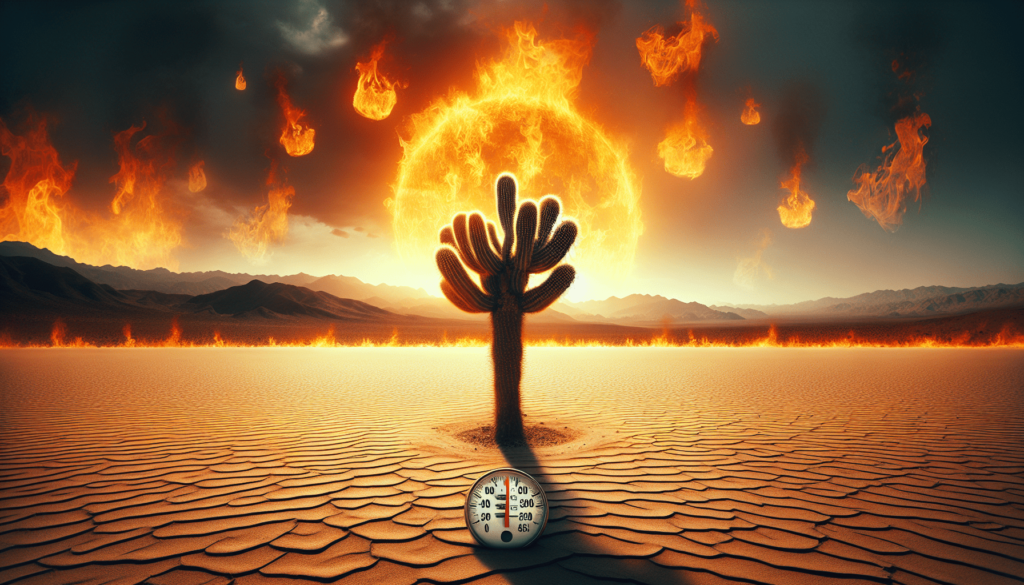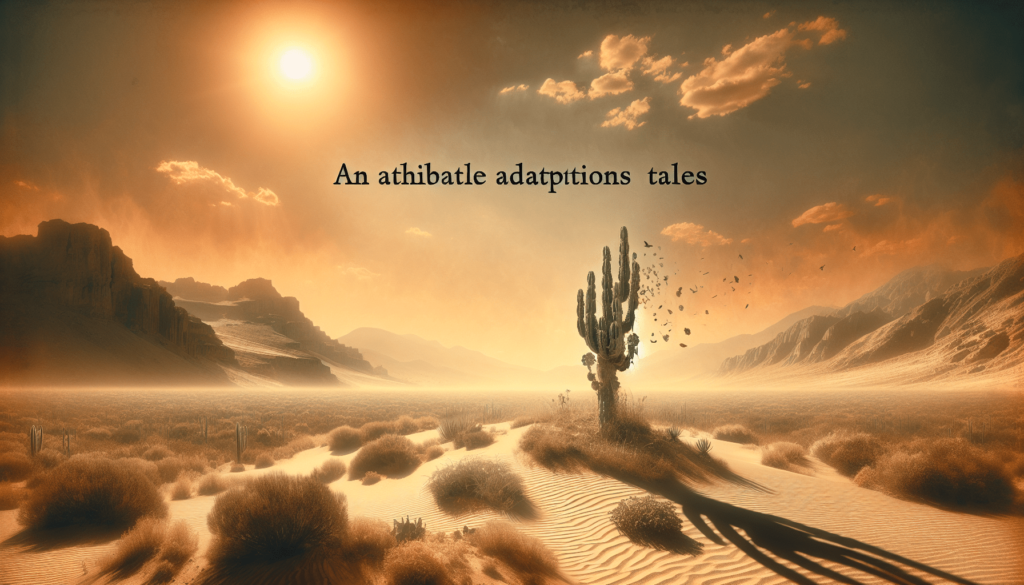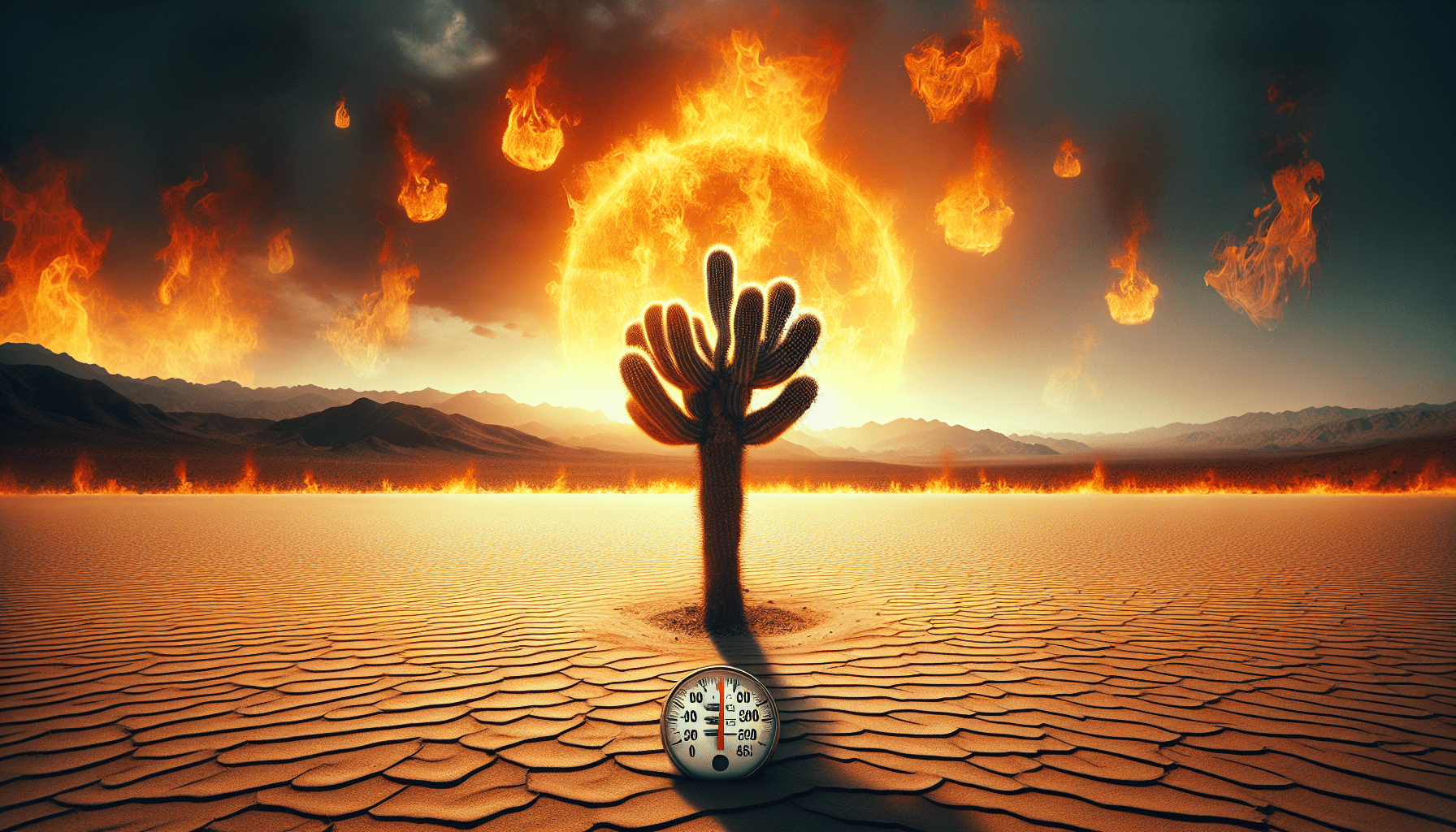In this article, you will explore the profound effects that climate change has on wildlife. As temperatures rise and weather patterns become increasingly unpredictable, our planet’s diverse ecosystems and animal species are facing unprecedented challenges. From melting polar ice caps to the destruction of habitats, the delicate balance of nature is being disrupted. Prepare to witness the remarkable resilience and vulnerability of various wildlife species as they adapt, migrate, or face potential extinction in the face of this global crisis.

Habitat Loss and Fragmentation
Changes in Temperature and Precipitation Patterns
Climate change is causing significant changes in temperature and precipitation patterns around the world. As temperatures continue to rise, many animal species are finding it increasingly difficult to survive and thrive in their natural habitats. Warmer temperatures can lead to droughts, heatwaves, and increased evaporation, which can result in a reduction of available water sources for wildlife. This can have detrimental effects on the survival and reproductive success of many species.
Deforestation and Urbanization
Deforestation and urbanization are two major factors contributing to habitat loss and fragmentation. As human populations continue to grow, more land is being cleared for agriculture, infrastructure, and settlements. This widespread destruction of natural habitats leaves wildlife with limited space and resources. Urbanization, in particular, creates a barrier for many species, preventing them from accessing necessary food sources, mating partners, and suitable habitats.
Disruption of Migration Patterns
Climate change is disrupting the traditional migration patterns of many animal species. As temperatures and weather patterns change, the timing and routes of migration are being altered. This can lead to a mismatch between the timing of migration and the availability of resources at destination sites. It can also result in increased competition for limited resources, making it more difficult for some species to successfully complete their migration journeys. This disruption can have far-reaching consequences for entire ecosystems, as the absence or reduced presence of certain species can disrupt the delicate balance of interdependent relationships.
Species Range Shifts and Distribution
Shifts in Temperature and Climate Zones
As temperatures continue to rise, many species are experiencing shifts in their natural ranges and distribution patterns. Some species are moving towards cooler regions or higher elevations in search of suitable climates, while others are being forced to retreat to smaller areas as their preferred habitats become less habitable. These shifts in temperature and climate zones can have profound effects on the composition of ecosystems, potentially leading to the displacement or extinction of certain species.
Altered Habitat Suitability
With changing climatic conditions, the suitability of habitats for various species is being compromised. As temperatures rise, certain habitats may become too hot or dry for species that are adapted to cooler and more humid conditions. Conversely, habitats that were once too cold or inhospitable may become more suitable for species that are adapted to warmer climates. These changes in habitat suitability can result in changes in species composition, as well as increased competition for limited resources within the remaining suitable habitats.
Implications for Endangered Species
Endangered species are particularly vulnerable to the impacts of climate change. With their already limited populations and habitats, any additional stressors can push them closer to the brink of extinction. Changes in temperature, habitat suitability, and migration patterns can all pose significant challenges for endangered species, potentially leading to reduced reproductive success, increased predation risks, and decreased availability of food sources. Efforts to mitigate the impacts of climate change on endangered species are crucial to ensuring their long-term survival.
Impact on Reproductive Cycles and Breeding
Changes in Breeding Seasons
Climate change can disrupt the timing of breeding seasons for many animal species. As temperatures shift and become more unpredictable, the cues that trigger the start of breeding seasons may be altered. This can lead to mismatches between the timing of reproduction and the availability of resources needed for successful breeding and rearing of offspring. For example, if a species relies on a certain plant species for nesting or feeding their young, but the plant’s flowering or fruiting period occurs earlier or later than usual, it can negatively impact the reproductive success of the species.
Altered Timing of Reproduction
In addition to changes in breeding seasons, climate change can also lead to altered timing of specific reproductive events within a breeding season. For example, warmer temperatures can advance the timing of egg-laying in birds or the onset of estrus in mammals. These changes in timing can disrupt the synchronization of reproduction among individuals within a population, potentially leading to reduced reproductive success or mismatches in food availability for offspring.
Reduced Reproductive Success
Climate change can directly and indirectly impact the reproductive success of many animal species. Extreme weather events, such as heatwaves, floods, or droughts, can directly harm individuals or destroy nests, eggs, or offspring. Increased competition for resources, such as food or mates, due to changes in habitat suitability can also reduce reproductive success. Furthermore, changes in temperature and precipitation patterns can alter the availability and quality of food sources, impacting the health and condition of individuals and their ability to successfully breed.

Ecological Imbalances and Food Web Disruptions
Changes in Phenology
Phenology refers to the timing of biological events, such as flowering, leafing, or migration, in response to seasonal changes. Climate change can disrupt phenological patterns, leading to mismatches in the timing of key events within ecosystems. For example, if the peak abundance of a certain insect species, which serves as an important food source for birds, occurs earlier or later than usual, it can result in reduced food availability and reproductive success for the birds. These changes in phenology can have cascading effects throughout the food web, impacting multiple species and their interactions.
Shifts in Trophic Interactions
Changes in temperature and habitat suitability can influence the distribution and abundance of prey and predator species, leading to shifts in trophic interactions within ecosystems. For example, as certain plant species decline or disappear due to changing climate conditions, herbivorous species that rely on these plants may also decline in numbers or be forced to adapt to feeding on alternative plant species. This, in turn, can impact the predators that rely on the herbivores as a food source, potentially leading to imbalances in predator-prey relationships.
Altered Predation Patterns
Climate change can influence the behavior, distribution, and abundance of predator species, leading to shifts in predation patterns within ecosystems. As temperatures rise and habitats change, some predators may expand their ranges or find new prey species to target. Conversely, certain prey species may become more vulnerable to predation as their preferred habitats become increasingly inhospitable or other predator species increase in abundance. These altered predation patterns can have significant consequences for population dynamics and the overall functioning of ecosystems.
Increased Susceptibility to Diseases
Spread of Emerging Diseases
Climate change has been linked to the spread and emergence of various infectious diseases in wildlife populations. Warmer temperatures, changes in precipitation patterns, and altered habitat suitability can create favorable conditions for the survival and transmission of disease-causing pathogens. Additionally, as species shift their ranges or come into contact with new species due to changing climatic conditions, the potential for disease transmission between different species increases. This can have profound impacts on population dynamics, as well as the health and survival of individual animals.
Impaired Immune Responses
Climate change can negatively impact the immune systems of wildlife, making them more susceptible to diseases and infections. Stressors such as extreme temperatures, changes in food availability, and habitat degradation can weaken immune responses, leaving animals more vulnerable to pathogens. As a result, wildlife populations may experience higher mortality rates, reduced reproductive success, and overall population declines.
Effects on Population Dynamics
The increased susceptibility to diseases caused by climate change can have cascading effects on population dynamics. Outbreaks of diseases can lead to significant mortality events and a decline in population numbers. In some cases, entire populations or species may be wiped out by newly emerging or expanding diseases. Even if mortality rates are not immediately noticeable, the long-term effects of compromised immune systems can reduce reproductive success and hinder the recovery of populations, ultimately leading to population declines.
Loss of Biodiversity
Extinction Risk for Vulnerable Species
Climate change poses a significant threat to many vulnerable and endangered species, increasing their risk of extinction. Changes in temperature, habitat suitability, and availability of resources can result in reduced population sizes, decreased reproductive success, and increased competition for limited resources. As these stressors accumulate and intensify, species that are already at risk due to other factors, such as habitat loss and fragmentation, are pushed closer to the brink of extinction.
Loss of Keystone Species
Keystone species play critical roles in maintaining the balance and functioning of ecosystems. Climate change can directly and indirectly impact the survival and abundance of keystone species, resulting in disruptions to ecosystem processes and interactions. For example, the loss of a keystone predator can lead to an increase in the population of its prey species, which can then negatively impact other species further down the food chain. These disruptions can have far-reaching effects on ecological communities and reduce the resilience of ecosystems to future disturbances.
Ecosystem Functioning and Resilience
The loss of biodiversity caused by climate change can have detrimental effects on the functioning and resilience of ecosystems. Biodiversity provides important ecosystem services, such as nutrient cycling, pollination, and pest control, which are essential for maintaining healthy ecosystems and supporting human well-being. As species are lost, the ability of ecosystems to respond and adapt to changing environmental conditions is diminished, making them more vulnerable to further disturbances and less able to provide the services upon which we rely.
Impact on Marine Wildlife
Ocean Acidification
Climate change is leading to the acidification of the world’s oceans, primarily due to increased carbon dioxide (CO2) emissions. As CO2 dissolves in seawater, it forms carbonic acid, which lowers the pH of the ocean. This acidification can have detrimental effects on marine wildlife, particularly those with calcium carbonate shells or skeletons, such as corals, shellfish, and some plankton species. As the pH decreases, it becomes more difficult for these organisms to build and maintain their protective structures, leading to reduced growth rates and increased vulnerability to predation.
Coral Bleaching
Rising water temperatures and increased ocean acidity are major contributors to coral bleaching. Corals have a mutualistic relationship with algae called zooxanthellae, which provide them with energy through photosynthesis. However, under stressful conditions, such as high temperatures or increased acidity, corals expel their zooxanthellae, resulting in coral bleaching. Without their zooxanthellae, corals lose their color and become more susceptible to disease, leading to widespread coral mortality. This has devastating consequences for coral reef ecosystems, as corals provide habitat and food sources for numerous marine species.
Disruption of Coral Reef Ecosystems
Climate change poses a significant threat to coral reef ecosystems, which are among the most biodiverse and productive ecosystems on the planet. The combination of rising temperatures, ocean acidification, and increased storm intensity can lead to mass coral bleaching events, where large areas of coral reefs experience high levels of mortality. This loss of coral cover has cascading effects throughout the entire reef ecosystem, impacting the abundance and diversity of fish and other marine species that rely on corals for food and shelter. The destruction of coral reef ecosystems not only disrupts marine biodiversity but also affects the livelihoods and food security of millions of people who depend on reef resources.
Implications for Polar and Cold-Adapted Species
Accelerated Melting of Arctic Sea Ice
Climate change is causing the accelerated melting of Arctic sea ice, primarily due to rising temperatures. This loss of sea ice has wide-ranging impacts on polar and cold-adapted species, such as polar bears, seals, and walruses, which rely on the ice as a platform for hunting, breeding, and resting. As the ice retreats further and for longer periods, these species are forced to travel longer distances to find suitable hunting grounds or resting places. This can result in increased energy expenditure, reduced reproductive success, and higher mortality rates, ultimately threatening the survival of these iconic Arctic species.
Threats to Polar Bears and Other Species
Polar bears are particularly vulnerable to the impacts of climate change due to their dependence on sea ice as a hunting platform. With the loss of sea ice, polar bears face reduced access to their primary prey, seals, leading to increased energy expenditure and decreased reproductive success. As the ice-free period lengthens, polar bears are also more likely to come into contact with human settlements in search of food, leading to increased conflicts and human-bear interactions. Additionally, other cold-adapted species, such as Arctic foxes, reindeer, and certain bird species, are also facing significant challenges as their habitats and food sources are threatened by climate change.
Loss of Sea Ice Habitat
The loss of sea ice habitat due to climate change has profound implications for polar and cold-adapted species. Sea ice serves as a critical platform for hunting, feeding, breeding, and resting for many species in the Arctic and Antarctic regions. As the ice melts and retreats, these species are forced to adapt to a changing environment or face increasing difficulties in finding suitable habitats and food sources. The loss of sea ice also has broader ecological consequences, as it disrupts feeding relationships, alters nutrient cycling, and reduces the availability of ice-associated species that form the base of the food web.
Collapse of Ecosystems and Trophic Cascades
Direct and Indirect Effects on Ecosystems
Climate change can directly and indirectly impact ecosystems, leading to the collapse of ecological communities and trophic cascades. Direct effects can include habitat loss, extreme weather events, and changes in temperature and precipitation patterns, which can directly harm or kill individuals and disrupt important ecological processes. Indirect effects can result from changes in species interactions, such as altered predation patterns or changes in the availability of food sources, which can have cascading effects throughout the food web. These collapsing ecosystems can result in reduced biodiversity, decreased ecosystem functioning, and increased vulnerability to further disturbances.
Altered Food Availability and Energy Flow
Climate change can disrupt the availability of food sources for many species, leading to changes in energy flow and trophic dynamics within ecosystems. For example, changes in temperature and weather patterns can impact the emergence of insects, which are an important food source for many bird species. If the timing of insect emergence changes or if insect populations decline due to extreme weather events, it can have negative consequences for bird populations that rely on insects for food. These disruptions in food availability and energy flow can have far-reaching effects on ecosystem stability and the survival of dependent species.
Disruptions in Natural Balance
The collapse of ecosystems caused by climate change can lead to disruptions in the natural balance of ecological communities. When certain species decline or disappear due to changing climate conditions, it can result in an overabundance of other species or a loss of key interactions within the community. For example, the decline of a top predator can lead to an increase in the population of its prey species, which can then negatively impact other species further down the food chain. These disruptions in natural balance can have cascading effects throughout the ecosystem, leading to reduced biodiversity, altered nutrient cycling, and decreased resilience to future disturbances.
Conservation and Mitigation Strategies
Protected Area Networks and Wildlife Corridors
Establishing protected area networks and wildlife corridors is crucial for conserving biodiversity and facilitating species movement in the face of climate change. Protected areas provide habitat protection and help maintain important ecological processes, while wildlife corridors allow for the movement of species between fragmented habitats, increasing the chances of survival and adaptation. By strategically identifying and managing protected areas and corridors, conservation efforts can help mitigate the impacts of climate change on wildlife and promote the long-term persistence of species and ecosystems.
Habitat Restoration and Reforestation
Restoring degraded habitats and engaging in reforestation efforts can play a vital role in mitigating the impacts of climate change on wildlife. By restoring and expanding natural habitats, we can provide essential resources and refuge for species to cope with changing climatic conditions. Reforestation efforts, in particular, can help sequester carbon dioxide from the atmosphere, mitigating greenhouse gas emissions and alleviating some of the drivers of climate change. These restoration and reforestation initiatives provide multiple benefits, including improved habitat connectivity, increased biodiversity, and enhanced ecosystem resilience.
Promoting Sustainable Practices
Promoting sustainable practices at local, regional, and global scales is crucial for addressing the impacts of climate change on wildlife. This includes actions to reduce greenhouse gas emissions, such as transitioning to renewable energy sources, improving energy efficiency, and promoting sustainable transportation. Additionally, sustainable land management practices, such as agroforestry and organic farming, can help reduce habitat loss, conserve biodiversity, and enhance ecosystem functioning. By adopting and supporting sustainable practices, we can minimize our ecological footprint and contribute to the long-term conservation of wildlife and their habitats.
In conclusion, climate change poses significant threats to wildlife around the world. From habitat loss and fragmentation to disruptions in migration patterns, changes in reproductive cycles, ecological imbalances, increased disease susceptibility, loss of biodiversity, and impacts on marine and polar species, the consequences are far-reaching and potentially devastating. However, there are conservation and mitigation strategies that can help mitigate these impacts, including protected area networks, habitat restoration and reforestation, and promoting sustainable practices. By taking collective action to address the impacts of climate change, we can protect and preserve the incredible diversity of life on Earth.

